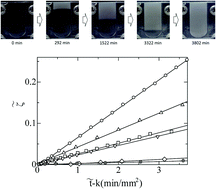Study of plasma coagulation induced by contact with calcium chloride solution
Abstract
Blood coagulation capability is one of the most important factors for the diagnosis of patients with thrombosis. Regarding the blood coagulation as an example of gelation of soft matter, we can apply an analytical method to this phenomenon and pick up some relevant parameters. In various systems, gelation dynamics induced by contact between a polymer solution and a crosslinker solution are well explained by the “moving boundary picture” (Yamamoto et al., J. Phys. Chem. B, 2010, 114, 10002–10009). The aim of this paper is to clarify whether this picture can be applied to a clinically important biological system used for blood coagulation tests. We have measured the time course of the thickness of a plasma gel layer formed when plasma comes in contact with calcium chloride solution in a rectangular cell and analyzed theoretically on the basis of the moving boundary picture. The entire process was well expressed using a scaled equation involving three parameters characterizing the plasma, k, Kin, and β, where k is the time required to reach the incipient stage of three-dimensional network formation, the parameter Kin is proportional to calcium chloride concentration and β is a constant. These results indicate the direct applicability of the general theory of gelation dynamics induced by contact between two solutions to the in vitro coagulation (gelation) of plasma, and the fitting parameters may be used for diagnosis.


 Please wait while we load your content...
Please wait while we load your content...